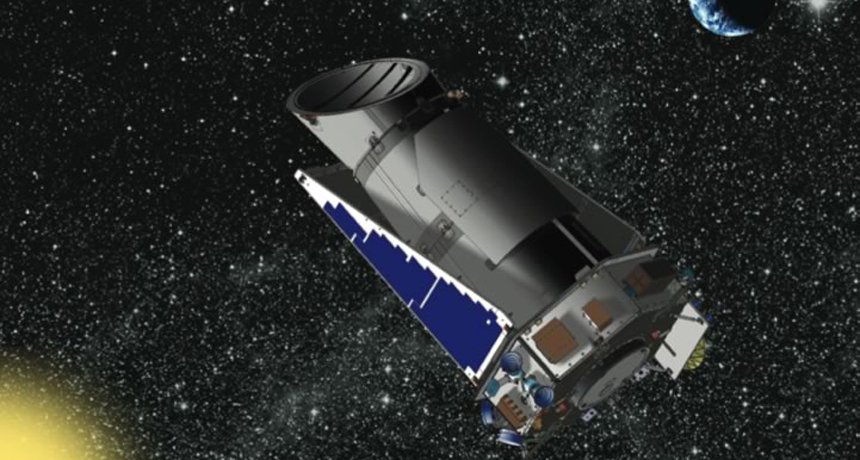Kepler’s surprise: Planet hunter also found supernovas
Now-defunct telescope captured five stellar explosions as they happened

SUPERNOVA SPOTTER NASA’s Kepler space telescope, illustrated here, did more than just find planets. New research shows that it discovered at least five explosions of giant stars.
NASA
OXON HILL, Md. — NASA’s premier planet-hunting telescope had an unexpected talent: spotting the cataclysmic demise of giant stars. The Kepler space telescope detected at least five supernovas, giving astronomers a rare look at these calamitous explosions from the start.
From May 2009 until May 2013, when a critical piece of equipment failed (SN: 9/21/13, p. 18), the Kepler telescope found at least 3,500 likely planets orbiting other stars. Kepler’s planet-hunting prowess stemmed from doing one thing extremely well: measuring the brightness of some 170,000 stars. For all four years, the telescope stared continuously at a single patch of sky, collecting brightness measurements every 30 minutes. Occasionally the scope detected subtle dips in stars’ brightness, revealing that planets had crossed in front of them and cast shadows.
In late 2009, Rob Olling, an astronomer at the University of Maryland in College Park, who studies supernovas and black holes, began to wonder what Kepler could do if it stared at galaxies. Like stars, galaxies shine with relatively consistent brightness. But should something extraordinary happen — perhaps the explosion of a giant star, or a feeding frenzy by an immense black hole — a galaxy’s brightness would soar. After Olling and Maryland colleagues Richard Mushotzky and Ed Shaya submitted a proposal to the Kepler team, the telescope began monitoring 400 galaxies within its field of view.
Kepler data revealed at least five and possibly eight supernovas over a two-year period, Olling reported January 8 at a meeting of the American Astronomical Society. In some ways, the data are rudimentary: They consist only of brightness measurements, so astronomers can’t figure out details such as the supernovas’ structures and the chemical composition of the shrapnel. And Kepler beamed data to Earth only once every 90 days. Because supernovas fade away after several weeks, astronomers couldn’t point other telescopes at the supernovas that Kepler identified to collect more-precise observations.
Yet no other telescope has chronicled a supernova so meticulously, from the first signs of the explosion through its peak and dimming. Prior studies have analyzed the origins of supernovas by studying sky images taken just before and after a supernova appeared (SN: 3/9/13, p. 16), but they could not spy on the very first moments of the explosion. “It’s really neat because Kepler is observing the star already before it explodes,” said Nathan Smith, an astronomer at the University of Arizona in Tucson who was not involved in the research. “Then [Kepler] sees the supernova immediately and watches it brighten.”
At least two of the Kepler supernovas are type Ia, the most commonly detected variety. Kepler’s data have already provided a key clue as to what sets these explosions off. Astronomers hypothesize that type Ia explosions are triggered by the collision of an unknown type of star with a white dwarf, the Earth-sized corpse of a star like the sun. If the first star is large, then its surface should glow as it falls victim to the explosion’s blast wave – well before the supernova reaches peak brightness. However, the Kepler data showed no such initial glow, which suggests that the colliding object is relatively small, perhaps another white dwarf.
The supernova survey was cut short when Kepler broke down last year. But NASA is mulling a proposal to revive Kepler with a mission called K2; if it proceeds, Olling hopes to study about 20,000 galactic targets in the telescope’s new field of view. He wants telescopes on the ground to look at the same area to make more-detailed observations of any explosions that Kepler finds. Obtaining supernova data with both Kepler and a ground-based telescope would give astronomers an unprecedented case study.
There’s just one hitch: Under the leading K2 proposal, the telescope would point at a patch of sky close to the sun. That’s fine for a space telescope, but it would make observations from the ground impossible. “We’re trying to present the case to the K2 team to look in the other direction,” Olling said.







